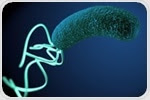|
| | Microbiology | |
| | The latest microbiology news from AZoNetwork | |
|
|
|
|
 |
| | Scientists solve 3D structure of vaccinia virus RNA polymerase  For viruses to multiply, they usually need the support of the cells they infect. In many cases, only in their host's nucleus can they find the machines, enzymes and building blocks with which they can multiply their genetic material before infecting other cells. For viruses to multiply, they usually need the support of the cells they infect. In many cases, only in their host's nucleus can they find the machines, enzymes and building blocks with which they can multiply their genetic material before infecting other cells. | |
|
| | Parasites could have originated from transmissable cancers  Researchers have presented a controversial new theory suggesting that transmissible cancers could eventually evolve into their own multicellular species. Until fairly recently, parasites called myxosporeans were thought to be offshoots of the eukaryotic line that is not plant, animal or fungi. However, in 1995, researchers Mark Siddall and colleagues posited that myxosporeans are actually unusual types of cnidarians – a group that includes corals and jellyfish. Since then, genetic research has generated evidence to support that idea. Researchers have presented a controversial new theory suggesting that transmissible cancers could eventually evolve into their own multicellular species. Until fairly recently, parasites called myxosporeans were thought to be offshoots of the eukaryotic line that is not plant, animal or fungi. However, in 1995, researchers Mark Siddall and colleagues posited that myxosporeans are actually unusual types of cnidarians – a group that includes corals and jellyfish. Since then, genetic research has generated evidence to support that idea. | |
|
| | Mechanisms behind antibiotic resistance captured on video for the first time  In a world-first, scientists have established the cause of antibiotic-resistance in bacteria, capturing video footage showing that bacteria have the ability to change their form in order to avoid detection by antibiotics. This contradicts existing beliefs around how bacteria can survive without a cell wall. Known as L-form switching, this ability to evade antibiotics poses a significant threat to global health. In a world-first, scientists have established the cause of antibiotic-resistance in bacteria, capturing video footage showing that bacteria have the ability to change their form in order to avoid detection by antibiotics. This contradicts existing beliefs around how bacteria can survive without a cell wall. Known as L-form switching, this ability to evade antibiotics poses a significant threat to global health. | |
|
| | Scientists modify a toxic protein to create a biosensor  Some types of bacteria kill other cells by releasing proteins called “pore-forming toxins” (PFTs) that create holes in the cell membrane. The PFTs bind to the cell membrane and burrow into, creating a tube-like channel or pore. Once enough holes have been punched into the cell membrane by these toxins, the target cell destroys itself. Some types of bacteria kill other cells by releasing proteins called “pore-forming toxins” (PFTs) that create holes in the cell membrane. The PFTs bind to the cell membrane and burrow into, creating a tube-like channel or pore. Once enough holes have been punched into the cell membrane by these toxins, the target cell destroys itself. | |
|
|
|
|






























.png)











No hay comentarios:
Publicar un comentario